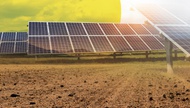When Frank Rieger, owner of local solar panel retailer and installer Sol-Up, moved to the Valley and started his company with one employee in 2009, he says there was “pretty much no solar at all.” But he saw a unique opportunity in Las Vegas.
“Nobody had solar on the roof … and the fascinating thing is, it’s not just the amount of sunshine in the state. It’s also the unobstructed roofs. So, there’s little shading issues compared to other places in the world,” he says.
Today, Rieger’s company has grown to more than 150 employees, and has set up an office in Reno. That’s no huge surprise, considering Nevada has risen in the ranks to No. 1 for solar jobs per capita, according to the Interstate Renewable Energy Council’s 2022 National Solar Jobs Census.
With 7,562 solar jobs, Nevada lags behind California in the sheer number of jobs. (California had more than 78,000 jobs in 2022). But it beat the Golden State and Utah in terms of jobs distributed among the population.
And Nevada ranks sixth in terms of cumulative solar electric capacity installed. According to the Solar Energy Industries Association (SEIA), the Silver State has installed 5,409 megawatts, enough to power 911,561 homes and provide nearly 23% of electricity statewide.
It wasn’t a straight rise to the top, however, Rieger says. As the state has gotten more on board with solar, different policies have helped, and hindered, his company’s growth. “At the beginning, the most important subsidies were rebates from the utility company,” he says. “Unfortunately, these were never sustainable.”
Now, the industry has some “certainty,” thanks to the Inflation Reduction Act, he says. The $738 billion spending bill signed into law in August 2022 increased and extended the federal solar investment tax credit, allowing nonrefundable tax credits up to 30% of installation costs through at least 2032, according to the Department of Energy’s website.
The incentive is considered one of the most important policy mechanisms to support the growth of the industry in the U.S. According to the SEIA, since the investment tax credit was enacted in 2006, the solar industry has grown 200 times larger. Without the Inflation Reduction Act, the tax credit would have expired at the end of 2023.
“I think the Inflation Reduction Act has had a huge impact, because it gave the solar industry a future,” Rieger says. “[It] gives us, finally, a timescale for 10 years, so we can predict our business cases. And this gives certainty to us as an installer but also to our customers, which is really crucial.”
According to a White House fact sheet on Nevada, the legislation will bring an estimated $2.7 billion investment in large-scale clean power generation and storage to Nevada between now and 2030. “For solar, uptake projections estimate that over 75,000 additional Nevada households will install rooftop panels as a result,” the fact sheet reads.
Nevada Sen. Jacky Rosen, who toured Sol-Up in April to hear how solar tax credits from the Inflation Reduction Act were helping business, tells the Weekly that the legislation and clean energy investments she helped to pass can help lower energy costs and create thousands of jobs in the state.
“With solar, wind, hydropower, and geothermal energy, Nevada is uniquely positioned to lead the nation in the transition to clean energy while creating thousands of good-paying, union jobs along the way. Investments in our state’s clean energy future are investments in our economy,” Rosen says. “Thanks to the Inflation Reduction Act I was proud to help pass, we are going to help lower energy costs for hardworking Nevada families, support small businesses, and continue creating good-paying jobs in our state.”
Tariffs investigation impact
On the other hand, a federal investigation—into companies allegedly circumventing antidumping duties on solar panels sourced from China—has apparently hindered the industry. The Department of Commerce’s investigation, which began in March 2022, created uncertainty as to whether the Obama-era tariffs would be imposed retroactively on companies that supply about 80% of U.S. panel imports, according to Reuters.
After the investigation was announced, installation forecasts were cut nearly in half, as installers braced for higher prices of solar panels. An SEIA survey of 730 U.S. solar companies found 70% of respondents reporting that at least half of their workforce was at risk as a result of the probe.
In June 2022, the Biden administration announced that, while the investigation continued, it would waive the tariffs for two years in an effort to help the solar industry’s continued growth (important for the White House’s goal to zero out carbon emissions from electricity by 2035). On August 18, the Department of Commerce issued a final decision saying the tariffs will be implemented. With Biden’s two-year waiver, they will not be due until 2024.
Rosen, who led bipartisan colleagues in urging Biden to bring a swift conclusion to the investigation, condemned the final decision as “misguided” and argued it would impede the solar industry’s ability to grow. “While this decision is narrower than the original petition called for, it will still hurt the solar industry and solar companies’ ability to grow. Let me be clear: this misguided decision is going to directly affect our nation’s solar economy,” reads a statement from the senator, in part.
Ed Gilliland, senior director of strategic initiatives for the Interstate Renewable Energy Council, says the policy seems to have had an impact on utility-scale (power plant) solar jobs in 2022.
According to the 2022 National Solar Jobs Census, 6,000 utility-scale jobs were lost last year. However, about 9,500 jobs were added in the residential market.
“Overall, utility-scale jobs were down nationally. And the only reason we did experience growth was that the residential market had a very strong year,” he says. “This appears to be turning around, and we do expect the utility-scale jobs to come back a lot stronger this year, which should bode well for Nevada, because there’s a lot of utility-scale development going on.”
Click HERE to subscribe for free to the Weekly Fix, the digital edition of Las Vegas Weekly! Stay up to date with the latest on Las Vegas concerts, shows, restaurants, bars and more, sent directly to your inbox!




